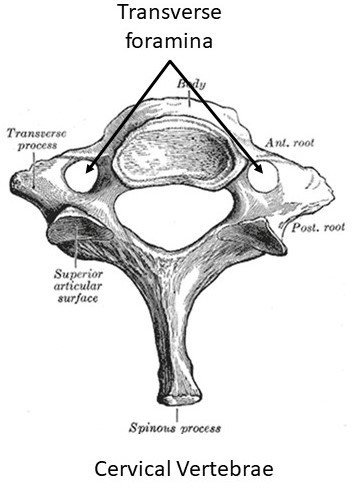Cervical vertebrae have which landmark that's not found on any other?
Spinous Process.
Transvers Processes.
Costal Facets.
Transverse Foramina.
The Correct Answer is D
The transverse foramina are openings in the transverse processes of the cervical vertebrae that allow the passage of the vertebral arteries and veins.
They are not found on any other vertebrae.

Choice A is incorrect because spinous processes are bony projections on the posterior aspect of all vertebrae that serve as attachment sites for muscles and ligaments.
Choice B is incorrect because transverse processes are lateral projections on all vertebrae that serve as attachment sites for muscles and ribs.
Choice C is incorrect because costal facets are articular surfaces on the thoracic vertebrae that articulate with the heads of the ribs.
They are found on all thoracic vertebrae except T11 and T123.
Nursing Test Bank
Naxlex Comprehensive Predictor Exams
Related Questions
Correct Answer is D
Explanation
A cartilaginous joint is a joint where the bones are united by cartilage.
A hyaline cartilage joint is a type of cartilaginous joint where the bones are joined by hyaline cartilage.
An example of a hyaline cartilage joint is the first sternocostal joint that unites the first rib to the sternum.
Choice A is incorrect because hyaline cartilage joints are not present in the maxilla.
The maxilla is a single bone that forms the upper jaw and palate. Choice B is incorrect because none is not a valid answer.
Choice C is incorrect because fibrous cartilage joints are not present in the skull. The skull bones are joined by fibrous joints called sutures.
Correct Answer is ["Intercondylar eminence of the tibia"]
Explanation
The intercondylar eminence of the tibia is a prominent bony ridge located on the superior aspect of the tibial plateau, which is the top surface of the tibia bone that articulates with the femur.
The eminence separates the two condyles of the tibia and serves as an attachment site for several ligaments, including the anterior and posterior cruciate ligaments of the knee joint.
These ligaments play a critical role in stabilizing the knee joint and preventing excessive forward or backward movement of the tibia relative to the femur.
The intercondylar eminence also provides a surface for the menisci, which are C- shaped fibrocartilaginous structures that help absorb shock and distribute forces in the knee joint.

Whether you are a student looking to ace your exams or a practicing nurse seeking to enhance your expertise , our nursing education contents will empower you with the confidence and competence to make a difference in the lives of patients and become a respected leader in the healthcare field.
Visit Naxlex, invest in your future and unlock endless possibilities with our unparalleled nursing education contents today
Report Wrong Answer on the Current Question
Do you disagree with the answer? If yes, what is your expected answer? Explain.
Kindly be descriptive with the issue you are facing.
